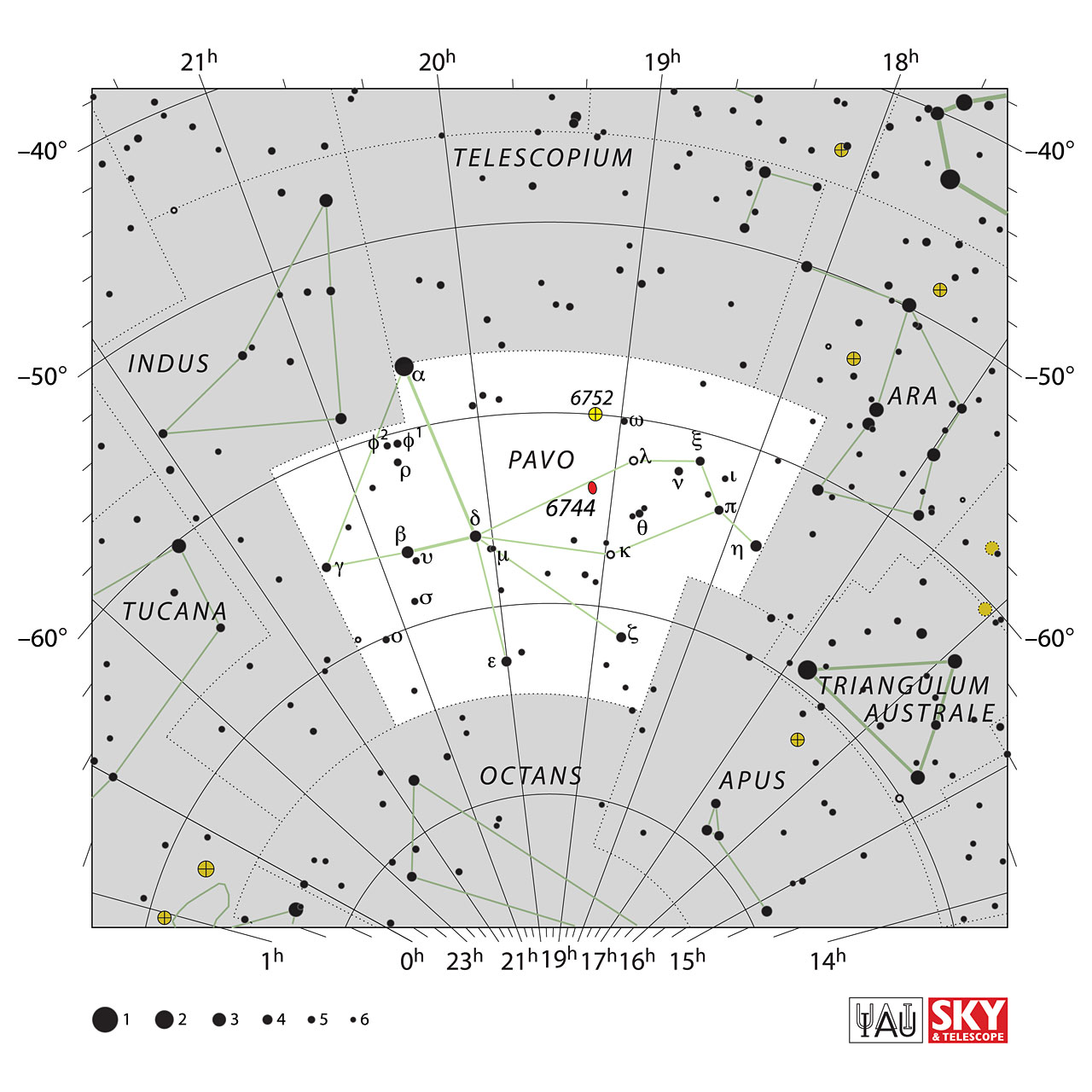Pavo


Pavo lies close to the south celestial pole, where it is circumpolar across most of the southern hemisphere, but appears highest in the midnight sky in the months around July.
It was among a dozen constellations introduced by Pieter Dirkszoon Keyser and Frederick de Houtman which celebrate rare or exotic animals, and first appeared on star maps in 1598.
It is home to one second-magnitude star, called Peacock, but no other stars brighter than mag 3.4.
Lying away from the Milky Way, Pavo does not have many bright deep sky objects, with the exception of the globular cluster NGC 6752.
In Greek myth the stars that are now the Peacock were Argos [or Argus], builder of the ship Argo. He was changed by the goddess Juno into a peacock and placed in the sky along with his ship.
Some accounts of Greek mythology present the story in the following way.The peacock and the “Argus” nomenclature are also prominent in a different myth, in which Io, a beautiful princess of Argos, was lusted after by Zeus (Jupiter). Zeus changed Io into a heifer to deceive his wife (and sister) Hera and couple with her. Hera saw through Zeus’s scheme and asked for the heifer as a gift. Zeus, unable to refuse such a reasonable request, reluctantly gave the heifer to Hera, who promptly banished Io and arranged for Argus Panoptes, a creature with one hundred eyes, to guard the now-pregnant Io from Zeus. Meanwhile, Zeus entreated Hermes to save Io; Hermes used music to lull Argus Panoptes to sleep, then slew him. Hera adorned the tail of a peacock—her favorite bird—with Argus’s eyes in his honor.
In the Indian system, Pavo is called ಮಯೂರ (Mayura) which is the translation for Peacock.
Pavo contains:
-
Stars
- Peacock (mag 1.9)
- β-Pav (mag 3.4)
- δ-Pav (mag 3.5)
- η-Pav (mag 3.6)
- ε-Pav (mag 3.9)
- ζ-Pav (mag 4.0)
- λ-Pav (mag 4.2)
- γ-Pav (mag 4.2)
- π-Pav (mag 4.3)
- κ-Pav (mag 4.4)
- ξ-Pav (mag 4.4)
- ν-Pav (mag 4.6)
- φ¹-Pav (mag 4.8)
- HD 172555 (mag 4.8)
- ρ-Pav (mag 4.9)
- O-Pav (mag 5.1)
- NU Pav (mag 5.1)
- υ-Pav (mag 5.1)
- φ²-Pav (mag 5.1)
- ω-Pav (mag 5.1)
- HD 188162 (mag 5.2)
- HD 177389 (mag 5.3)
- μ²-Pav (mag 5.3)
- HD 186219 (mag 5.4)
- σ-Pav (mag 5.4)
-
Open Clusters
- None
-
Globular Clusters
- NGC 6752 (mag 5.4)
- None
-
Galaxy
- NGC 6744 (mag 9.0)
- IC 4820 (mag 9.2)
- NGC 6684 (mag 10.4)
- NGC 6753 (mag 11.0)
- IC 4662 (mag 11.1)
- NGC 6810 (mag 11.2)
- NGC 6943 (mag 11.2)
- IC 4765 (mag 11.4)
- NGC 7020 (mag 11.5)
- NGC 6876 (mag 11.5)
- IC 4845 (mag 11.6)
- NGC 6872 (mag 11.6)
- IC 4721 (mag 11.6)
- IC 5052 (mag 11.7)
- NGC 6769 (mag 11.8)
- NGC 6782 (mag 11.8)
- NGC 6770 (mag 11.9)
- NGC 6776 (mag 12.0)
- NGC 6699 (mag 12.0)
- NGC 6721 (mag 12.0)
- IC 4842 (mag 12.3)
- IC 4901 (mag 12.3)
- NGC 7059 (mag 12.3)
- IC 4852 (mag 12.4)
- NGC 6771 (mag 12.5)
View Pavo in 3D 
Source: Wikipedia, in-the-sky.org
Image Courtesy: Sky&Telescope & IAU, Illustration Images linked from Urania's Mirror on Wikmedia Commons by Sidney Hall
Image Courtesy: Sky&Telescope & IAU, Illustration Images linked from Urania's Mirror on Wikmedia Commons by Sidney Hall
